Main Page > blog > B2B General Marketing > The Full Guide to Developing a B2B Buyer PersonaThe Full Guide to Developing a B2B Buyer Persona
Developing B2B buyer persona(s) is a fundamental step for any B2B business because it is crucial for tailoring your messages to align with the specific characteristics, needs, and preferences of your prospects or existing customers.
If your messages are relevant and well-tailored for your prospects, they are more likely to pay attention and consider your solutions.
Although almost everyone recognizes the importance of developing a buyer persona, the real challenge lies in how to develop them.
However, this guide will cover everything you need to know about developing a B2B buyer persona.
This full guide will cover the following points:
- What is buyer persona?
- Difference between B2B and B2C buyer personas?
- Why developing B2B buyer personas is important.
- Steps for developing a B2B buyer persona.
- B2B buyer persona template
- B2B buyer personas examples
- How to use B2B buyer personas
- Examples of how the use of B2B buyer personas can enhance your content personalization
- Wrapping up.
What Is B2B Buyer Persona?
A B2B buyer persona (also referred to as B2B customer avatar) is a semi-fictional representation of your ideal customer based on market research and real data about your existing customers.
It goes beyond basic demographic information to include detailed insights into the motivations, behaviors, challenges, and goals of the individuals or groups who are most likely to buy your products or services.
I will give in the final parts of this article detailed examples of B2B buyer persona profiles, but I will give a simplified one now to help you understand the definition mentioned previously.
Let’s say that you’re a business that sells an accounting software that helps in creating the accounting report, and streamlining the accounting team’s efforts.
In this case, your buyer persona will look like this:

Obviously, neither ‘Henry’ nor TechX is real. However, Henry and TechX are just fictional entities that represent who your prospects and customers are in a detailed manner.
There are many missed elements and data in the example above, but keep in mind that I provided it to help you understand what a buyer persona profile looks like, and as I said previously, I will give you more detailed examples in the final parts of this article.
However, now that you understand what is a buyer persona, let’s find out what is the difference between B2B and B2C buyer personas.
B2B And B2C buyer persona Key Differences
When it comes to buyer personas, B2B and B2C businesses differ in a lot of aspects in how to create them.
For instance, B2B businesses don’t focus so much on some details like age, gender, income, lifestyle and much more demographic information that B2C businesses aim to collect.
But rather, B2B businesses focus on information related to business and buying process like industry, responsibilities, role, position, company, and many other demographic and firmographic data.
Here are the key differences between B2B and B2C buyer personas:
1. Focus:
When it comes to B2B businesses, the focus is on companies that are purchasing products or services for use in their operations, production, or to resell.
B2B buyer personas often represent an individual with significant authority in the buying decision and the company to which they belong.
As for B2C businesses, the focus is on individual consumers purchasing products or services for personal use.
B2C buyer personas represent individual consumers with specific preferences, needs, and behaviors.
2. Characteristics:
B2B buyer personas’ characteristics include the industry sector, business size, job roles, business needs, and pain points.
B2B personas are detailed and consider the goals, difficulties, challenges, and complexities of business requirements.
On the other hand, B2C buyer personas’ characteristics include primarily demographic information (age, gender, income, etc…), psychographic information (interests, values, lifestyles), and behavioral traits.
3. Decision-Making Process:
In the B2B sector, the decision-making process is longer, more complex, and involves multiple stakeholders.
It often involve a formal procurement process with several stages, including need recognition, evaluation, and negotiation.
As for the B2C sector, the decision-making process is typically quicker and involves fewer stages. Decisions are often influenced by emotions, personal preferences, and immediate needs.
However, I will give you an example of a B2C buyer persona profile and I want you to compare it with the previous B2B customer avatar example.
Let’s say that you are a B2C business (ecommerce store) that sell products that can be used as gifts and offers for females above the age of 18.
In this case, here is how a B2C buyer persona profile looks like:
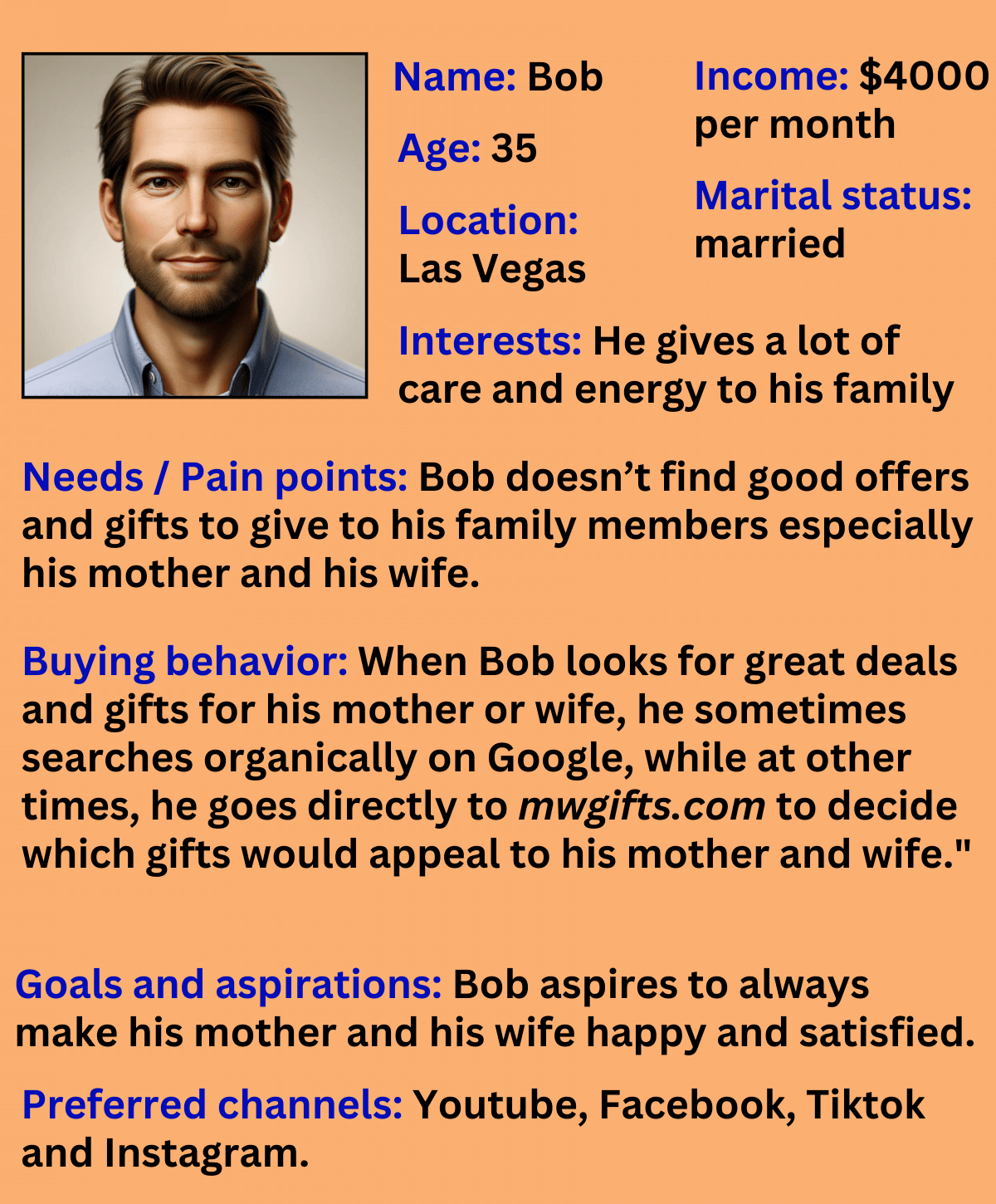
When you will compare those two examples provided previously, you will understand immediately the key differences I gave you above between B2B and B2C buyer personas.
Note: Keep in mind that the information you use to create your buyer personas (whether B2B or B2C) must be based on real data you collected from your CRM database or any other source of information, not from your head.
Why Creating B2B Buyer Persona Is Important?
Creating buyer personas for your B2B business is indispensable for tailoring your messages for your prospects and existing customers and for improving your overall marketing performance.
And in order to make you recognize their importance, I want you to consider the following benefits and statistics that demonstrate the importance of their integration in your marketing plan:
Benefits of Developing B2B Personas:
One of my favorite ways to demonstrate the importance of a particular element is by highlighting the benefits you can get from it.
And there are many benefits you can get from creating buyer personas including…
- Directly address problems customers are experiencing: Solving problems your customers face is crucial to customer loyalty and revenue generation. And so, your content in all formats must focus on problem solving, and your buyer persona profile helps in that.
- Use the right influencers to convince your B2B customers: Understanding which influencers your customers admire and heed is a crucial aspect of the content strategy framework. Including endorsements from these influencers in your content can be beneficial whenever possible.
- Use buying triggers in emails and real-time messaging: Although the B2B buying process is more complex, and generally, these copywriting techniques don’t always work seamlessly, because decisions can’t be taken by one individual even if he is convinced, but including some buying triggers that are based on your prospects goals and pain points can grab your prospect attention and affect its buying decision especially in the consideration stage.
- Rank content priorities: Personas are helpful when you have to create an editorial calendar that reflects true customer interest. Some content topics can be categorized as “nice to have” and others a “top priority”, and the list goes on…
Statistics That Prove the Importance of Developing a B2B Buyer Persona:
If you are not convinced yet of the importance of developing buyer personas for your B2B business. Consider the following statistics:
- 71% of businesses that exceed their revenue goals have established and officially recorded their customer personas (source: slideshare).
- Companies focused on customer-centricity are 60% more profitable compared to businesses that are not customer centric (source: venturebeat).
- 77% of customers have chosen, endorsed, or paid more for a brand that offers personalized experiences (source: instapage).
- 63% of customers tend to interact and reply more to messages tailored to them, rather than to generic, broad-appeal communication approaches (source: broadridge).
I think the benefits and statistics mentioned previously are enough to make you convinced, however, even if you didn’t realize where their importance lies, later in this article, I will give a realistic example of how can the act of using B2B buyer personas enhance your marketing efforts, so, keep reading…
Steps For Developing a B2B Buyer Persona
Now that we understood what B2B persona is and why developing one is important, I think it is time to delve into how to actually create it.
There are many steps involved in the B2B buyer persona development, and here is an overview of these steps before we delve in depth into each one:
- Identify your target audience.
- Determine which company department will use your product.
- Identify who is the decision-maker.
- Collect real data and information.
- Develop your B2B buyer persona.
Step 1: Identify And Understand Your Target Audience
There is no doubt that the first step you must take in order to develop a buyer persona for your B2B business is to identify and understand your target audience, which are companies you want to complete or enhance their business activities.
And in order to create a comprehensive buyer persona profile, you will need to collect some general information about your audience (target companies) that don’t require any interactions with your customers, and they must be included in your B2B customer avatar profile, which are:
- Industry: Knowing the industry allows you to tailor your solutions to meet the unique challenges and needs of businesses within that sector. In addition, familiarity with the industry’s language, pain points, and key performance indicators enables you to communicate more effectively with potential clients.
- Company size: Knowing your target companies size is important to identify which type of companies you are going to target, for instance, if you sell a high priced B2B product with a high quality, your target companies would be mid sized to large companies (you can measure a company size by its employees number and its yearly turnover).
- What problem your product solves for your target audience: Knowledge of the specific problem your product solves allows you to craft precise marketing messages that resonate with your target audience. You can communicate the benefits of your product more effectively when you articulate how it addresses a problem they are facing.
- Location: Are your target companies physically located in your city, country, or are they located abroad?
- Your target companies goals and objectives: Knowing what your target companies aim to achieve will help you tailor your messages based on their goals. This will make them more interested in your solutions than your competitors’, especially during the consideration stage.
Understanding your B2B target audience requires a mix of qualitative and quantitative research, so take your time doing it because it is a crucial step.
Step 2: Determine Which Department Will Use Your Product

Determining and understanding which department within a target company will use your B2B product is crucial for several key reasons.
This knowledge can significantly influence your product development, marketing strategy, sales approach, and customer support.
Here are the main reasons why it is important:
Tailored Product Development: Knowing the specific department that will use your product allows you to tailor its features and functionality to meet their unique needs. This can include customizing the user interface, integrating specific workflows, or including department-specific compliance features. Tailored products are more likely to meet the needs of users, leading to higher satisfaction and adoption rates.
Effective Marketing: When you know which department will use your product, you can craft more precise and relevant marketing messages. Your content can address the specific challenges, goals, and industry terminology of that department, making your marketing efforts more impactful.
Improved Sales Conversations: Sales teams armed with the knowledge of the target department can have more informed and relevant conversations with potential buyers. They can highlight features and benefits that are directly relevant to the department’s needs, address specific concerns, and anticipate objections. This relevance can shorten sales cycles and improve conversion rates.
Customized Training and Support: Understanding the departmental context of your product’s use allows you to offer more customized training and support. You can develop training materials that reflect the department’s workflows and challenges, making it easier for users to understand and adopt the product. Similarly, customer support can be tailored to anticipate and quickly resolve issues specific to that department’s use of your product.
However, the department that will use your product must be included in your B2B persona profile.
Step 3: Determine Who Is the Key Decision-Maker
Determining who is the decision -maker in the department that will use your product is the cornerstone of your B2B buyer persona development.
Clearly, the key decision-maker in your target department may not have the ultimate authority, especially if your solution impacts other departments’ operations due to its functionality or cost.
However, if you can convince that decision-maker, the likelihood of your product being adopted increases significantly.
Step 4: Collect Real Data And Information
Once you have determined who is the key decision-maker in your target department, it is time to start collecting real data and information about him.
To do this accurately, you will need to know two things: ‘what data to collect‘ and ‘where it should be collected from‘.
What Data to Collect?
As mentioned previously, once you have identified the key decision-maker, you must start collecting data and information about them to ensure you have all the components that will enable you to complete your customer avatar profile.
Here is a list of information about the key decision-maker you need to collect:
Professional Background: Understand their career trajectory, including current position, roles held, industries worked in, and professional expertise. This helps in customizing your pitch to resonate with their experiences and challenges.
Decision-Making Authority: Identify their level of decision-making authority within the organization. Are they the final decision-maker, or do they influence decisions at a higher level?
Business Goals and Challenges: Know the business objectives they are trying to achieve and the challenges they face in reaching those goals. This information enables you to position your product or service as a solution to their specific problems.
Interests and Preferences: Identify their content preferences and interests. What kind of articles do they read? What kind of content do they engage with the most? Which events do they attend? Which channels do they spend most of their free time on? Knowing this can help you create engaging content, in the right format, that catches their attention and interest.
Purchase history: If you are a B2B business that sells different products, then knowing what type of products these key decision-makers have decided to adopt is important, because you don’t want to keep wasting your budget on a segment of customers who are not interested in a specific product category.
Engagement History: Track their interactions with your company’s content, including website visits, webinar attendances, and email responses. This gives you insight into their interests and how they prefer to engage with vendors.
Social Media Activity: Review their activity on professional networks like LinkedIn. Posts, comments, and shared articles can give you information about what’s important to them.
Technological Environment: Understand the current technologies and solutions they use. This helps in positioning your product or service as compatible with or superior to their existing solutions.
Peer Influence and Networks: Identify who they turn to for advice or recommendations. Knowing the influencers and networks they trust can help you find the best influencers and thought leaders to collaborate with (B2B influencer marketing).
From Where to Collect Data?
There are many sources from which you can collect the required data, whether you have interacted with some customers before or not.
Here are 7 reliable sources from which you can mine the information you need:
Source 1: CRM Database
Your Customer Relationship Management (CRM) system is a gold mine of information on existing customers and prospects.
It can provide historical data on purchase history, engagement levels, and customer acquisition channel (source from where they came: blog, LinkedIn, YouTube…).
- Customer Acquisition Channels: This tracks the initial interaction or touchpoint through which a prospect entered your CRM, including referral sources such as organic search, social media platforms, email campaigns, direct website visits, or specific marketing campaigns. Identifying the source helps pinpoint the channels preferred by your prospects, guiding where to focus your marketing efforts.
- Purchase History: Records all the purchases a customer has made, detailing the product or service bought, the purchase date, amount spent, and frequency of purchases.
- Engagement Levels: CRM helps you measure how customers interact with your brand across various channels and platforms, monitoring metrics such as email open and click-through rates, website visitation behaviors, and social media interactions.
Source 2: Website Analytics
Website analytics provide detailed data about how visitors interact with your site, offering invaluable insights into user behavior, preferences, and type of content that generate engagement the most.
Here’s an expanded look at what website analytics can reveal:
- Visitor Demographics: Understand who is visiting your site in terms of geographic location, age, gender, and interests. This helps tailor content and marketing strategies to better suit your audience.
- Traffic Sources: Identify where your website traffic is coming from—whether through search engines (organic search), social media platforms, referral sites, or direct visits. This information allows you to identify channels where your prospects spend most of their time.
- Content Performance: Determine which pieces of content perform best in terms of attracting and engaging visitors. This guides content creation efforts, helping you produce more of what your audience values.
Source 3: Social Media Platforms
Social media platforms offer a treasure trove of data that can be instrumental in understanding your audience and creating customer avatars.
Here’s are the most relevant types of data you can collect from social media platforms:
LinkedIn Engagement Metrics: Track interactions on your posts, including likes, comments, shares, and identify the most type of professionals who engage with your content, this will help you in determining the professional background of your B2B buyer personas.
Content Performance: Analyze which types of content (articles, videos, infographics) resonate most with your audience, focusing on metrics like engagement rates and click-throughs to your site.
Audience Insights: Gather data on the demographics and interests of your social media audience, particularly on LinkedIn and online forums (related to your niche), to tailor your messaging and content strategies.
Customer Feedback and Engagement: Monitor and analyze feedback, questions, and discussions from customers and prospects on social media to gauge sentiment and identify common pain points or needs.
Social Listening for Industry Trends: Utilize social listening tools to keep tabs on industry trends, relevant discussions, and emerging topics of interest to your target audience.
Source 4: Sales Team Feedback
Gathering feedback from your sales team is a crucial data collection method for B2B businesses, offering deep insights into customer preferences, concerns, needs and pain points. Here’s how to leverage sales team feedback for strategic advantage:
Customer Pain Points and Needs: Sales representatives are on the front lines, directly interacting with prospects and customers. Their insights into the common challenges and needs expressed during sales conversations can guide product development, marketing messaging, and content creation to better address these areas.
Industry Trends: Sales teams can provide firsthand observations on emerging trends within your industry, as they discuss ongoing projects and pain points with a variety of clients. These insights can help anticipate market shifts and position your company as a forward-thinking leader.
Source 5: Customer Surveys and Interviews
Customer surveys and interviews are vital tools for B2B businesses to gather data and information directly from their target audience.
Demographic Information: Data on the customer’s role within their organization, industry, company size, and geographic location.
Product Usage Data: Insights into how customers use your product or service, including frequency, features most valued, and potential gaps in functionality.
Customer Challenges and Pain Points: Information on the challenges and pain points customers face in their businesses that your product or service may help to address.
Buying Criteria and Decision Factors: Insights into what factors customers consider most important when choosing a product or service, including pricing, features, support, and brand reputation.
Customer Expectations: Data on what customers expect from your product or service and how those expectations match up with their actual experience.
Source 6: Market Research Reports
Market research reports are rich sources of data for B2B companies, they offer data that can help massively in creating B2B buyer personas. From these reports, you can collect data such as:
Industry Trends: Information on current and emerging trends within your industry, including technological advancements, regulatory changes, and shifts in consumer behavior.
- Customer Segmentation: Insights into how the market is segmented by types of businesses, industry sectors, company size, geographic regions, and other relevant criteria.
- Technological Developments: Data on current and emerging technologies impacting your industry, including opportunities for innovation and potential disruption.
Source 7: Competitor Analysis
Competitor analysis in the context of B2B businesses involves collecting and analyzing data about your competitors. Here are the types of data you can collect from competitor analysis:
Marketing and Advertising Activities: Analysis of competitors’ marketing strategies, including advertising channels, digital marketing efforts, content strategy, and engagement tactics on social media.
Customer Base and Segments: Information on the types of customers your competitors target, including industry sectors, company size, and geographic markets.
- Customer Feedback and Reviews: Collecting customer reviews and feedback on competitors’ products or services to identify their satisfaction levels and any common complaints.
These were the most common and reliable sources of data you can use.
However, keep in mind that these sources can actually include more insightful data that can benefit your business, but our focus was on data that helps in creating B2B personas.
Here is a schedule that simplifies the details we have been talking about:
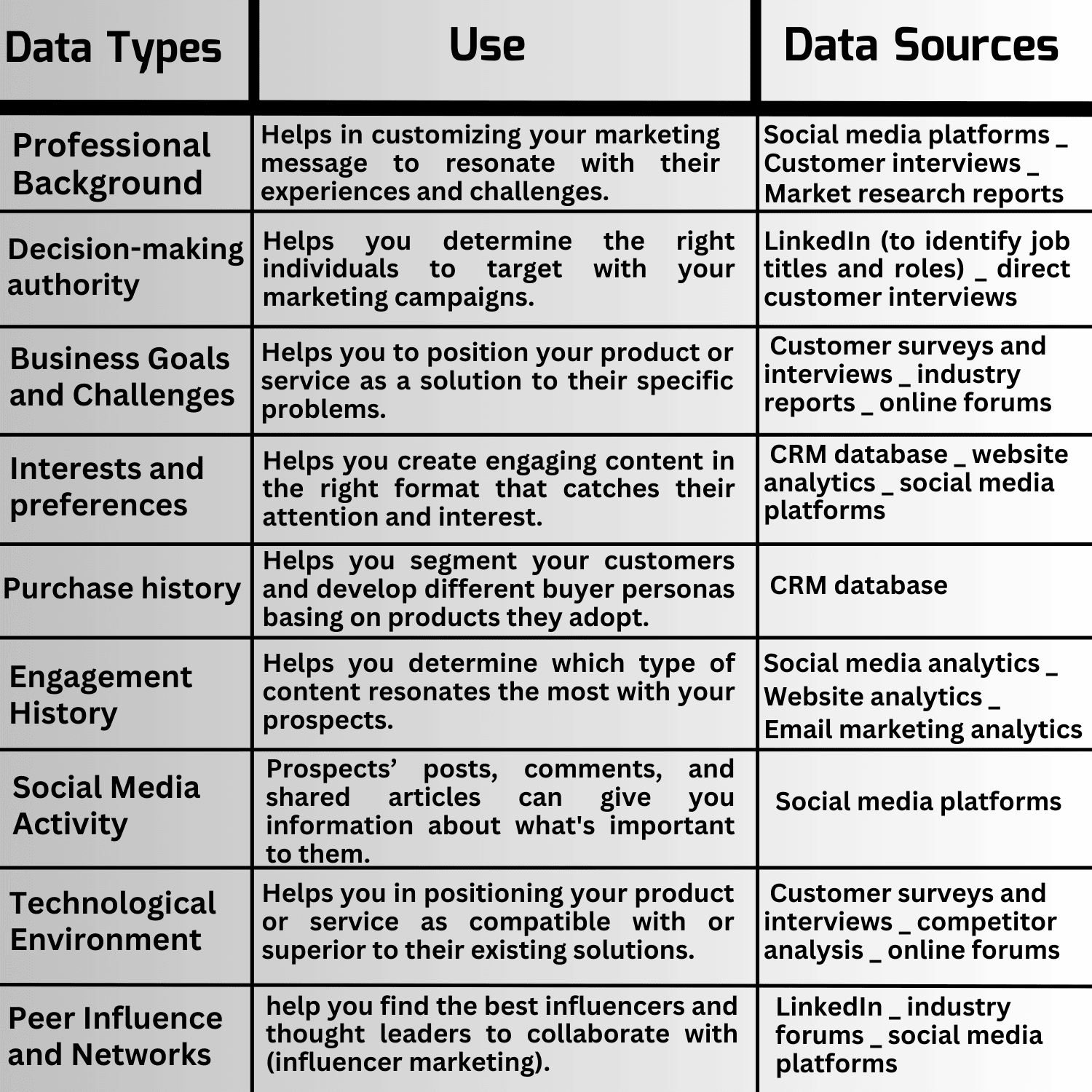
Step 5: Develop Your B2B Buyer Persona(s)
I think this step is the simplest one, now that you have collected the required information about your target audience and the key decision-maker(s), it is time for you to develop your customer avatar using that data.
The first thing you should do is organizing your collected data into segments containing customers with shared characteristics, such as the products they adopt, key decision-maker, the channels they use, and other information that significantly differentiates one group of customers from another.
Then you must represent each segment with a fictional person (key decision-maker) and company (target companies).
For example if you have a segment A that contains specific decision-makers and companies type, you will have to make them realistic by giving them a name and identity.
However, this step will be clearer for you once you use the B2B persona template I’m going to give.
B2B Buyer Persona Template:
When you have all the required data in hand, all you need to do is employing it accurately to create your customer avatar. And I’m here to help you.
So, all I want you to do is to fill the following, detailed B2B buyer persona template:
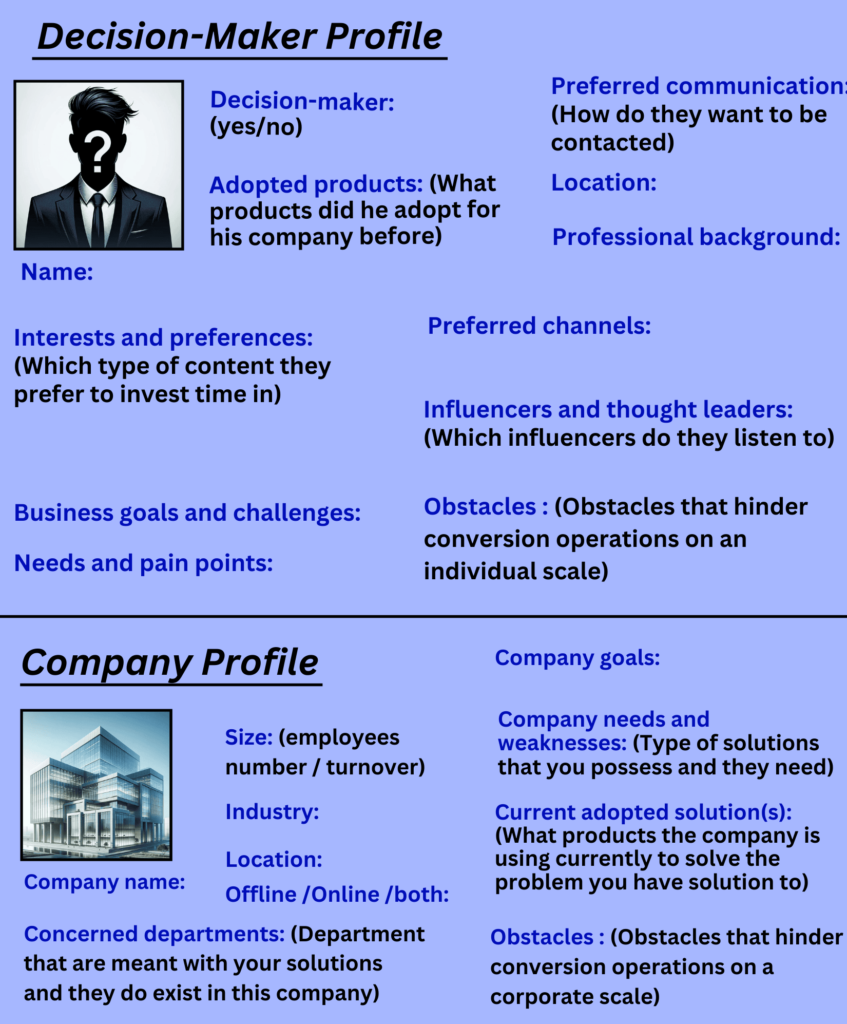
B2B Customer Avatar Examples:
In order to make the process clearer as much as possible, I will have to give some examples of a real-world B2B buyer personas.
And to do that effectively, let’s consider the following situation…
Let’s assume that you are a content marketer or a marketing manager, possibly even the owner, of a mid-sized company called ‘Pristine‘ in Dubai, which specializes in providing cleaning services to other local firms, your prices change according to your target company size.
Recognizing the value it can add to your marketing efforts, you decided to focus on developing B2B customer avatars.
The initial step involved identifying the companies you aim to target. While the industry of these companies wasn’t a primary concern, their size, whether they operate in a physical or virtual space and obstacles of conversion were critical information you need.
Eventually, you ended up segmenting your target companies into the following segments:
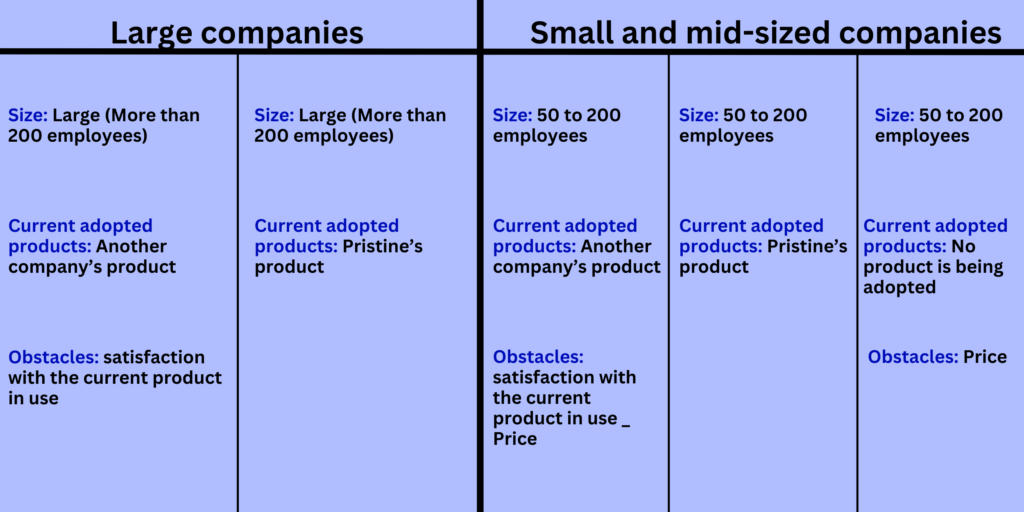
Once you segmented your target companies, you moved to the next step, which was determining which department would use your product.
However, since your service concerns the entire company, there was no specific department to target as the primary user.
Thus, you skipped this step and proceeded to the next one: identifying the key decision-maker.
After conducting some research on Google and doing customer surveys, you found that the ‘facilities director‘ holds the highest authority and relevance regarding the company’s physical buildings and facilities management and oversight (which includes the cleanliness of premises).
For small and mid-sized companies, you discovered that the CEO or the founder is the key decision-maker, as having a facilities director might still be costly for them.
And once you determined who are the key decision-makers, you started collecting real data and information using the methods and tools mentioned above.
You interviewed your customers, you looked for relevant information in online forums, you checked LinkedIn profiles of your key decision-makers, you mined relevant data from your CRM database, your read some industry reports…
Eventually you got the following and more:
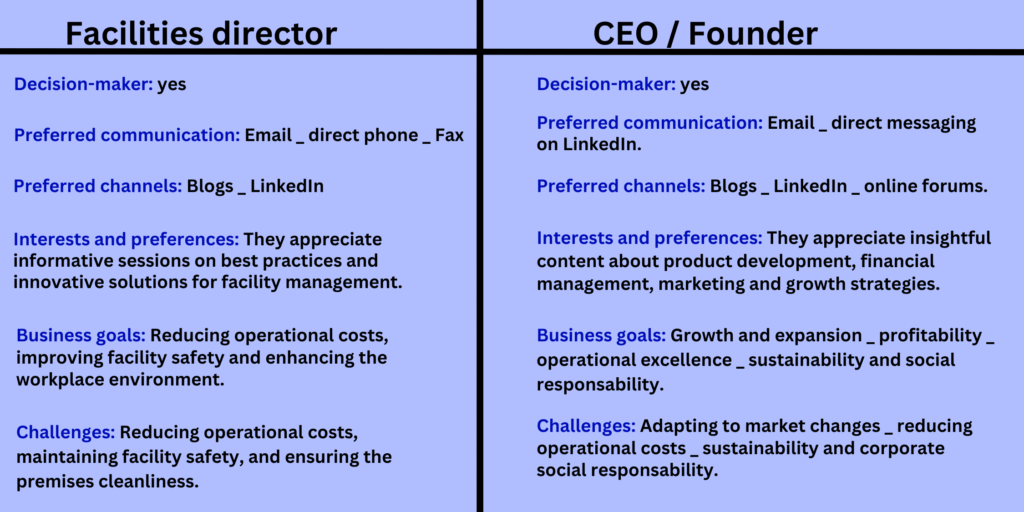
Now that you’ve gathered almost all the data you need, it’s time to create your B2B buyer persona using the template we provided.
When you finished developing them, here is what you got…
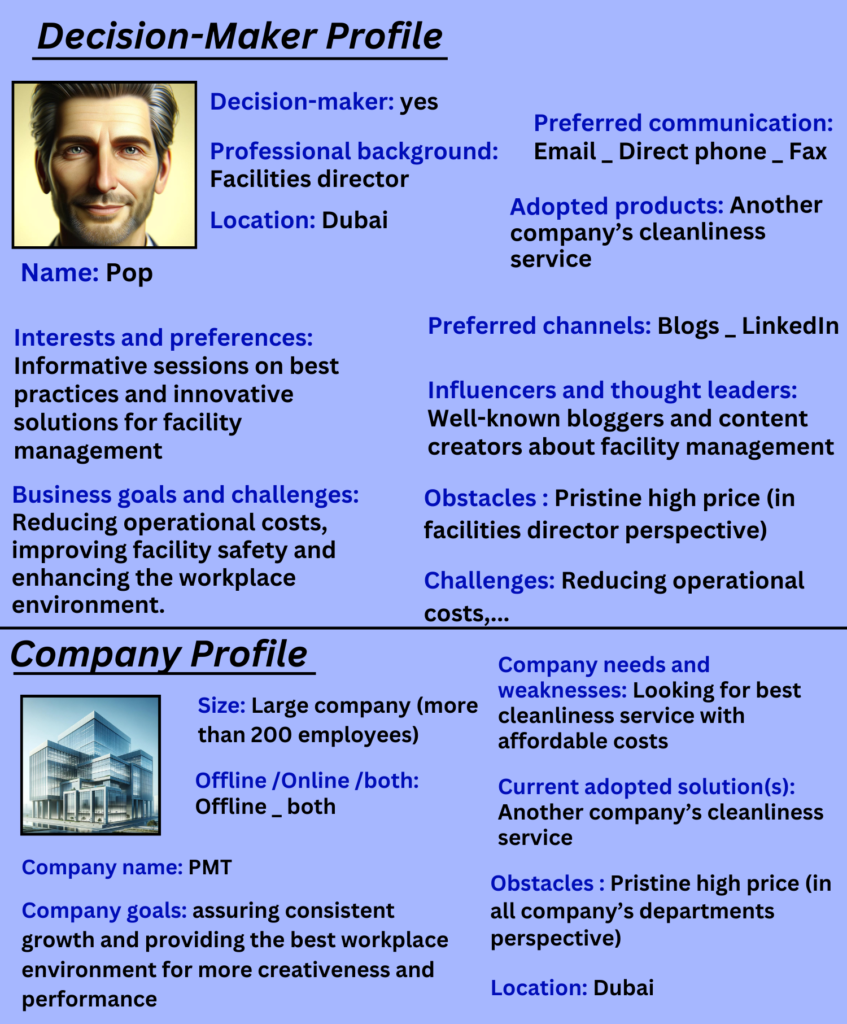

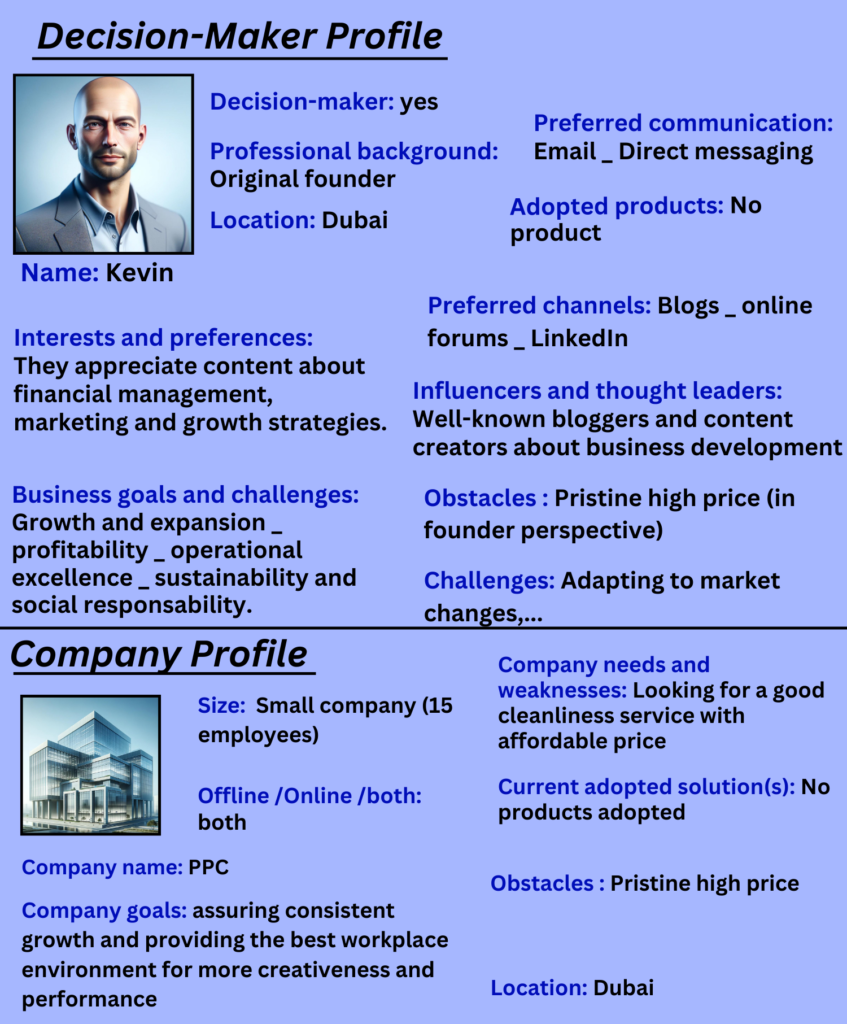
Warning: I will repeat it again, the information that you use must be real and based on your internal data or some real, trustworthy statistics and surveys!
However, you still need to create additional personas by identifying companies that already adopt your products and those that don’t, as well as distinguishing between those that have interacted with your company and those that have not, among other criteria we have previously determined.
Remember, the primary goal of creating buyer personas is to tailor our messaging and promotional materials as much as possible.
Now that you have successfully created your B2B customer avatars, you will absolutely want to know how to use them for your business advantage, and this is what we are going to discover in the next section of this article.
How to Use B2B Buyer Personas
Using B2B buyer personas involves primarily leveraging the data and information in the customer avatar profile and use it to tailor effectively your content and offers.
Here’s how you can use B2B buyer personas:
Tailoring Marketing Strategies: By understanding the specific needs and behaviors of different personas, you can tailor your marketing strategies to address the particular challenges and pain points of each group by using the collected information, this increases the relevance and effectiveness of your campaigns.
Content Personalization: Use personas to create content that resonates with your target audience. Whether it’s blog posts, white papers, or emails, speaking directly to the identified needs and interests of each persona can greatly improve engagement.
Product Development: Personas can inform your product development by highlighting specific features or services that are most valuable to your customers. This can guide you in making improvements or introducing new offerings that better meet the needs of your market.
Sales Alignment: Equip your sales team with persona information to help them understand the buyers they are engaging with. This can lead to more effective sales conversations and a higher conversion rate because the communication is highly relevant to the buyer’s context.
And you can use buyer personas in more ways. However, in order to illustrate how the use of B2B buyer personas can boost your marketing efforts, consider the following examples.
Examples Of How The Use Of B2B Buyer Personas Can Enhance Your Content Personalization
Let’s return to the situation we discussed before and imagine that you are a B2B business that sells cleanliness services for other firms.
And let’s consider two cases, the first case you didn’t develop personas, and in the second case you did, and then we will compare the content effectiveness in each case.
For example we will see how your content calendar and email copy would look like in each case.
Example 1: Your Content Calendar With and Without Using B2B Buyer Persona:
Let’s say that you wanted to create a content calendar for your cleanliness service provider business to generate leads, without using customer avatars.
As a content marketer of a cleanliness service provider business that has a general understanding of his target audience, here is how your content calendar without using B2B personas would look like:
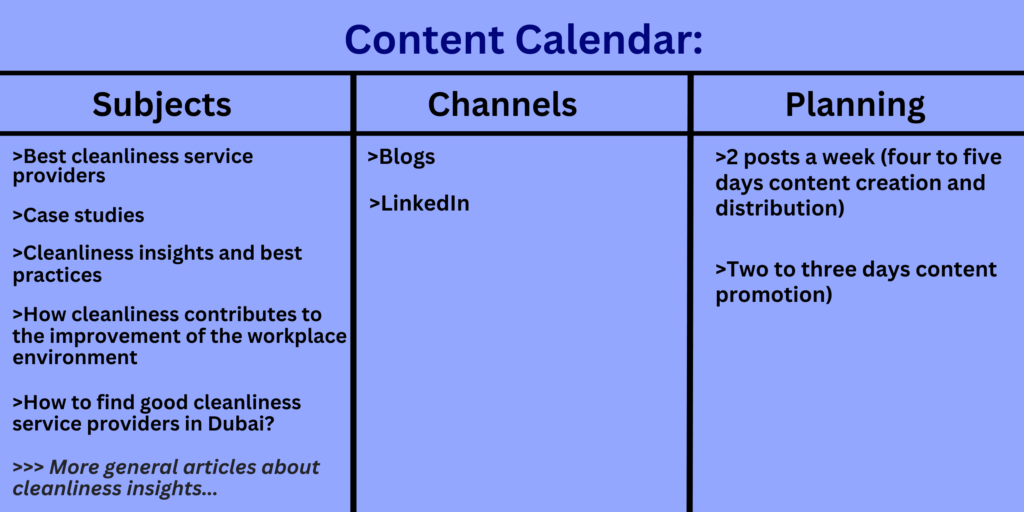
Here’s how your content calendar might look without using customer avatars: overly general, lacking in varied subject ideas, and devoid of personalization.
But more importantly, it fails to appeal to key decision-makers such as facilities directors, CEOs, and original founders, who are crucial to closing deals. Now, let’s see what your content calendar would look like when you use one.
Now, look at the following content calendar that you created based on your developed customer avatars profile:
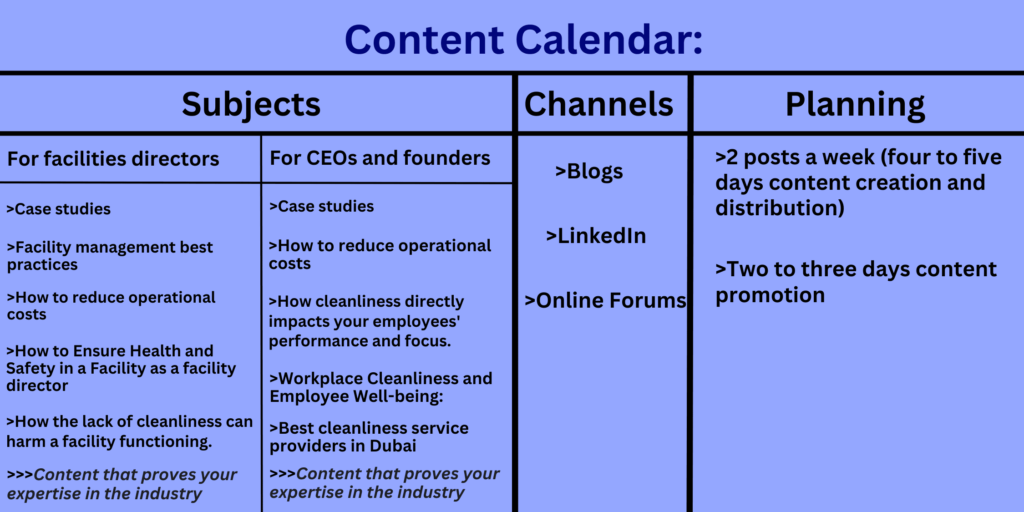
I just want you to compare these two content calendars and tell me which subjects are more likely to attract our key decision-makers; obviously, they are subjects in the the second content calendar!
And if you are asking how those customer avatar profiles contributed to the creation of the last content calendar, the answer is that I leveraged data and information about the key decision-makers (needs, interests) and used them to tailor my content and messages.
It is that simple; buyer personas help you tailor your content to make it more personalized and engaging, which can greatly increase your conversion rates and closed deals.
Note: The headings suggested above might not be good subjects for creating blog posts unless you conduct a keyword research and find that they contain good keywords. If they don’t, consider distributing them in the format of LinkedIn posts or sharing them in online forums.
Example 2: Your Email Copy With and Without Using B2B Buyer Persona:
Let’s imagine again that you are a content marketer working for that cleanliness company, and you want to send an email to some prospects—for example, to a CEO of a mid-sized company who perceives cleanliness services as being too costly (according to the collected data) to convince them that your company’s offer is the best choice for them.”
Here’s how your copy would look like without using buyer personas…
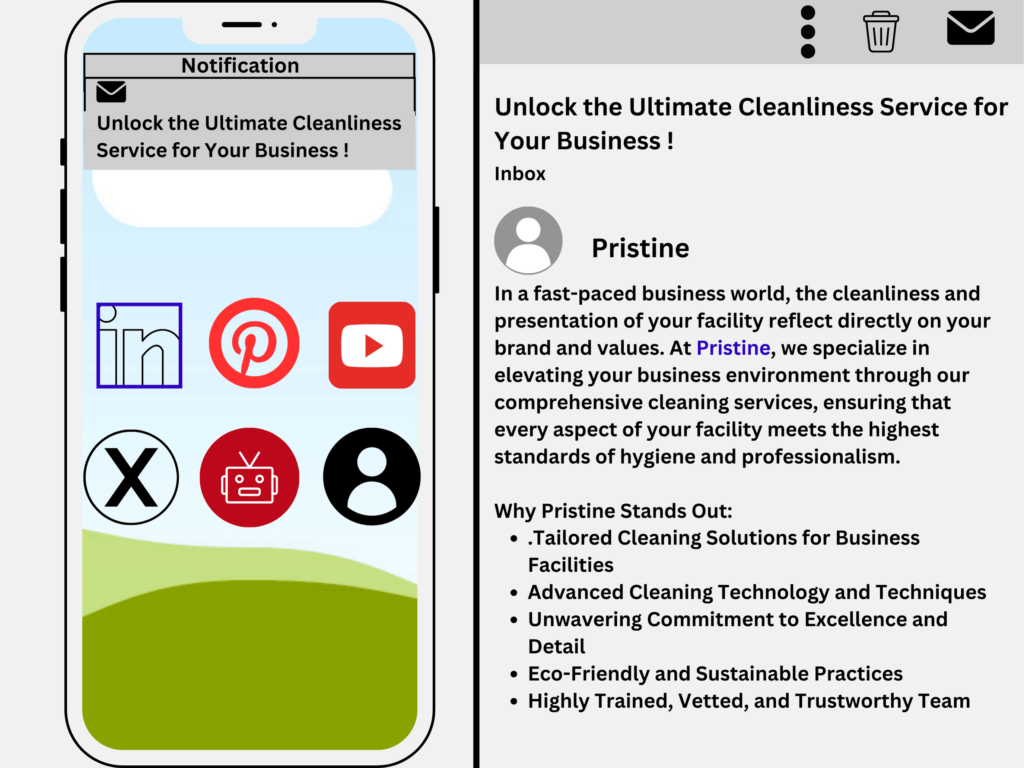
Not bad—the subject is catchy enough to grab a CEO’s attention, and the copy effectively communicates why a business should choose Pristine as its cleanliness service provider. However, I wonder if every CEO would continue reading the email until the end!
I think you noticed it, there is no personalization in the copy, the message is general and doesn’t address the CEOs’ needs specifically, it doesn’t mention their objectives, pain points or any other relevant information for him that might make him interested!
Now, I want you to read the following, adjusted email copy that is based on the B2B buyer persona profiles we developed earlier…
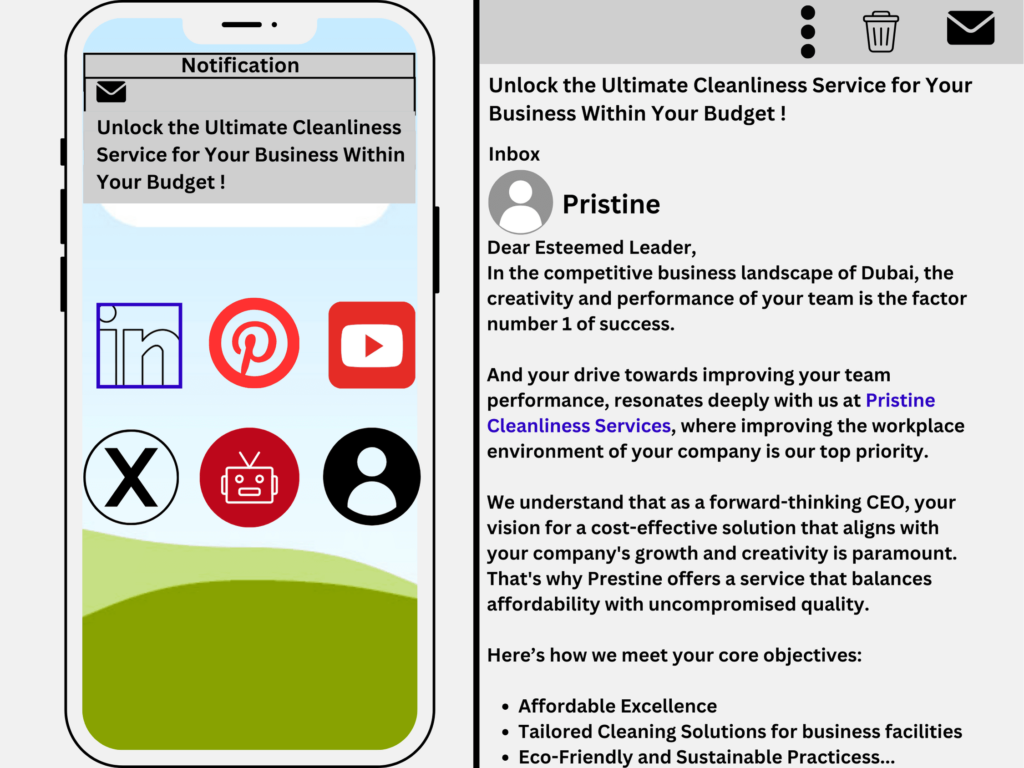
Upon careful reading, you will notice that the copy directly addresses CEOs in a personalized manner; it includes all the incentives and elements—goals, needs, location, pain points, and all the information from the persona profile—that will likely motivate your target CEOs to continue reading.
Information that will make him feel as if the message directed personally to him. And remember! 63% of customers tend to interact and reply more to messages tailored to them, rather than to generic, broad-appeal communication approaches.
I think these examples are far enough to show how you can use B2B buyer personas to your business advantage and how they can benefit your business.
Wrapping Up:
To wrap this up, B2B buyer personas are essential tools in the arsenal of modern business strategy, especially in marketing and sales.
They are detailed profiles of the ideal customers within a business’s target market, crafted through a combination of real-world data and educated assumptions.
These personas encompass demographic details, behavioral patterns, professional challenges, and personal motivations, giving businesses a blueprint of whom they are trying to reach.
In essence, B2B buyer personas are not just profiles; they’re actionable insights that, when integrated across business functions, can significantly enhance the alignment of product offerings with market demand, optimize customer engagement strategies, and drive business growth.
They serve as a foundational element in building customer-centric business practices that resonate with both the logical and emotional aspects of B2B purchasing decisions.
However, our guide to developing B2B buyer personas ends here.
I hope this was helpful. If you liked the content, subscribe to the HubRefs newsletter and don’t forget to share it with people you know they might get advantage of it…
Share
Subscribe to our newsletter for exclusive Insights into B2B content marketing and general B2B marketing approaches to lead your team and organization to ultimate success.
Written by Soufiane Zagouri.
